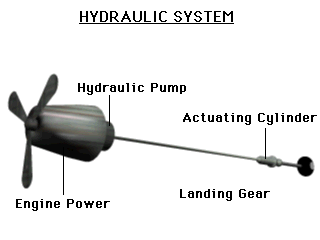 |
|||||
| Home | Research | For Teachers | HISTORY Level 1 Level 2 Level 3 |
PRINCIPLES Level 1 Level 2 Level 3 |
CAREER Level 1 Level 2 Level 3 |
| Gallery | Hot Links | What's New! | |||
| Web Administration and Tools | |||||
 |
|||||
| Home | Research | For Teachers | HISTORY Level 1 Level 2 Level 3 |
PRINCIPLES Level 1 Level 2 Level 3 |
CAREER Level 1 Level 2 Level 3 |
| Gallery | Hot Links | What's New! | |||
| Web Administration and Tools | |||||
![]()
Aircraft Hydraulics is a means of transmitting energy or power from one place to another efficiently.
 It
is a system where liquid under pressure is used to transmit this energy. Hydraulics
systems take engine power and converts it to hydraulic power by means of a hydraulic pump.
This power can be distributed throughout the airplane by means of tubing that runs through
the aircraft. Hydraulic power may be reconverted to mechanical power by means of an
actuating cylinder, or turbine.
It
is a system where liquid under pressure is used to transmit this energy. Hydraulics
systems take engine power and converts it to hydraulic power by means of a hydraulic pump.
This power can be distributed throughout the airplane by means of tubing that runs through
the aircraft. Hydraulic power may be reconverted to mechanical power by means of an
actuating cylinder, or turbine.
(1) - A hydraulic pump converts mechanical power to hydraulic power
(2) - An actuating cylinder converts hydraulic power to mechanical power
(3) - Landing Gear
(4) - Engine power (mechanical HP)
If an electrical system were used instead of a hydraulic system, a generator would take the place of the pump and a motor would take the place of the actuating cylinder.
(over other systems for aircraft use)
Example: A gun turret must be able to change direction
almost instantaneously. This is what is accomplished by this hydraulic system. In an
electrical system, the rotating armature must come to full stop and then reverse direction
or else the armature will burn out. This doesn't happen with a hydraulic system because
there is no need for a motor in the hydraulic system.
Example: In a landing gear the hydraulic
motor can produce enough power to pull up the landing gear system without trouble even
though air loads act on the system and the slip stream air is impinging against
it.
The actuating cylinder can change hydraulic power to linear or rotating
motion. It has a reduction gear in it to reduce rotating motion to that amount which is
needed. Previously, systems used to control motion by using steel cables
connected by pulleys between the controlling mechanism (such as the pedals) and the
controlled surface (such as the rudder). The cables were affected by expansion rates
of the cables due to temperature changes. Hydraulic systems can control motion
without worrying about the effect of temperature since it is a closed system (not open to
the atmosphere) compared to a cable system. This means better control of the plane and
less lag time between the pilot's movement to control the plane and the response by the
control surface.
Send all comments to ![]() aeromaster@eng.fiu.edu
aeromaster@eng.fiu.edu
© 1995-98 ALLSTAR Network. All rights reserved worldwide.
Updated: February 23, 1999